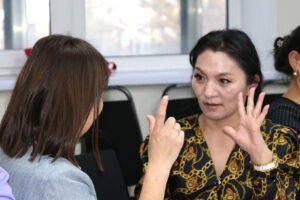Save the Children organized basic training of sign language

Save the Children in Mongolia is implementing the project “Promoting Inclusive Education for Every Last Child in Mongolia-2” funded by the Ministry of Foreign Affairs of Japan between 2021 and 2024 in 16 mainstream schools located in Bayanzurkh, Chingeltei and Songinokhairkhan districts of Ulaanbaatar city, as well as Khovd and Uvurkhangai provinces.
About 50 children with speech and hearing impairments study at primary and lower secondary levels of the project’s target schools. In order to work with these children and address their educational needs, it is necessary for teachers to learn sign language. To help solve this problem, we organized a three-day training session on the basics of sign language in Ulaanbaatar on 9-11 October 2023 in cooperation with the NGO “Mongolian Deaf Education”.
A total of 32 teachers from the target schools participated in the training. In addition, at the request of the Ministry of Labor and Social Protection, one specialist from each of the “Development Centers for Persons with Disabilities” established in Arkhangai, Darkhan-Uul, Dornod, Dundgobi, Khovd and Khuvsgul provinces attended this training.
Teachers studied Mongolian sign language in the three-day training session on the basics of sign language communication. They learned to express themselves with finger letters, counting, greetings, emotions, and facial expressions. They also communicated with each other in sign language. At the end of the training, the teachers and specialists who participated received a certificate of mastery of basic sign language knowledge and skills. These skills will be necessary for working with children with special educational needs and training other teachers and staff.

G. Uyanga, education project officer of Save the Children in Mongolia
G. Uyanga, education project officer of Save the Children in Mongolia, said: “This is a very useful training. Teachers gained basic knowledge of sign language and learned the methodology of daily communication with children with speech and hearing impairments. We believe that these skills can be used not only to communicate with students but also with parents who have speech and hearing impairments.”

Nyamzul, a Russian language teacher at the School No. 1 of Uyanga soum, Uvurkhangai province
Nyamzul, a Russian language teacher at the mainstream school No. 1 in Uyanga soum, Uvurkhangai province: “Our school has five students with special needs. Among them, one fourth-grade student needs to communicate in sign language. But this child doesn’t know sign language, and we teachers don’t know either, so we communicate through simple gestures, writing, and drawings. I am actively participating in this training and focusing more on the methodology of teaching sign language to children. At the same time, we wonder why we didn’t learn sign language earlier. If we had, some local children would not have fallen behind in their studies”.

B. Badamgarav, teacher of design and technology at Bayanzurkh District School No. 79
B. Badamgarav, teacher of design and technology at Bayanzurkh District School No. 79: “In this training, we learn the basics of communication with our students with hearing impairment, such as the alphabet of sign language, expression, and presentation through body language. In this way, we can teach children with speech and hearing impairment show to express themselves through drawing. Also, in my opinion, by greeting students in sign language and asking ‘How can I help you?’ or ‘How are you doing?’, the students will have a warmer attitude toward teachers, and their trust in teachers will be strengthened”.
Brief information about the project:
Save the Children in Mongolia is implementing the project “Promoting Inclusive Education for Every Last Child in Mongolia-2” funded by the Ministry of Foreign Affairs of Japan in 2021-2024. The project promotes inclusive education for children from targeted primary and lower secondary schools in Bayanzurkh, Chingeltei, and Songinokhairkhan districts of Ulaanbaatar city, as well as in Khovd and Uvurkhangai provinces.

